Wealth management (WM), a long-established and client-centric industry, has been historically robust in recovering from a financial crisis. Typically, the industry has quickly adopted new ways of working, business model transformations, and innovative and disruptive solutions to emerge stronger and better. The sector is primarily based on people-to-people interactions, coupled with the ability to provide personalized solutions built on individualistic risk and need profiles. Market and product knowledge remains critical to effectively generate higher alpha and manage wealth across investor categories (mass affluent, affluent, high net worth, and ultra-high net worth).
The growth of the global wealth management market has remained robust, driven by global GDP upswing, rising disposable incomes, and saving rates. Growing steadily at a CAGR of 6.2% in the last ten years, the industry achieved record growth of 9.6% in 20191 to reach $226 trillion in global wealth from $125 trillion in 2009. In the past, the industry well-weathered periods of financial crisis and resultant disruptions. However, recently, this sector is experiencing a decline in revenue margins due to cost and regulatory pressures, a proliferation of low-margin products, an evolving market, and global disruptions. The COVID-19 pandemic has challenged the traditional mode of client interactions, enervating the performance of players who are ill-equipped and slow to transition to digital channels. The pandemic-induced remote/virtual ways of working have reiterated the need for effective client interactions and collaborations over digital channels.
As wealth shifts to more digitally-adept individuals (millennials and Generation X), wealth managers look to reshape their business and client engagement models by integrating digital capabilities into their offerings. An estimated two-thirds2 of the total wealth and assets in the US will shift from the older generations (baby boomers and the silent generation) to the younger ones (millennials and Generation X) over the next 25 years. Emerging wealth tech companies, equipped with their digital prowess are aiming to expand into the wealth management space thereby posing a growing threat to incumbent organizations.
While advisor-led, high-touch business models remain the lifeblood of wealth management firms, digital assets and data-based insights are fast becoming key success factors for differentiation, especially for new-age clients. The future hints at the need for fewer advisors serving more clients with improved digital and data capabilities.
A comprehensive hybrid-advisory approach leveraging automation, data analytics, digital, and cloud solutions is the need of the hour.
1. The Case for Digitalization in Wealth Management
Rapid strides in technology and changing investor preferences and increasing sophistication are pushing wealth managers to rethink their business and client engagement strategies. Digitalization helps modern wealth advisors create and understand their client personas better, thereby moving away from “one size fits all” to a more customized approach. Choosing the right technology platform will drive down infrastructure costs and bring in improved productivity, speed, and scalability to the entire wealth management lifecycle and value chain.
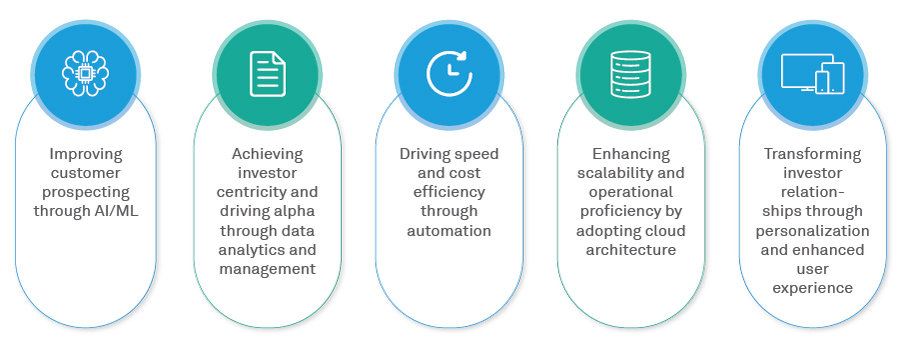
1.1. Improving Customer prospecting through AI/ML
Digitalization through AI/ML can help wealth managers identify the right prospects and drive customer acquisitions through data-led personalized marketing. With the capability to consolidate data from different sources, it can effectively classify customer segments based on multiple parameters, identify prospects through real-time data signals from social media, and dynamically generate personalized content for prospective customers, thereby improving customer acquisition.
1.2. Achieving investor centricity and driving alpha through data analytics and management
Wealth managers require reliable and real-time data to evaluate investor sentiments and key market metrics and generate insights for making swift decisions for their investors. Data can enable timely, relevant, and actionable insights to develop new (and improve existing) products and service propositions, optimize channel management, drive alpha through informed portfolio choices for the investor, increase investor engagement, and improve retention. A quantamental investment approach leveraging sentimental analysis, alternative data, and return analytics can enable wealth managers to make informed choices and necessary portfolio adjustments.
It is estimated 60% of wealth managers3 have developed their advisory and client analytics capabilities and are at varying stages of development and data building.
At present, wealth managers have most of their data locked in product silos and legacy systems. The consensus is to have access to clean and detailed data before applying advanced analytics. Wealth management firms require a client-centric and accurate master data infrastructure that consolidates data across the value chain. Wealth manager stands better chance to generate higher alpha by increasing their investment in data management and analytics as part of their digitalization initiatives.
1.3. Driving speed and cost efficiency through automation
Digital process automation (DPA) is the cornerstone of any digitalization journey due to its ability to provide delivery speed, process transparency, and operational efficiency. DPA can be broadly viewed as two streams: RPA (robotic process automation) and BPA (business process automation).
RPA brings in accuracy and efficiency in the execution of repetitive tasks, reducing execution time and costs. BPA, on the other hand, includes more-transparent automation on workflow-based business process activities.
From a value chain perspective, wealth management activities can be segregated into front-office, middle-office, and back-office divisions. The below table outlines how RPA and BPA can be effective for the relevant categories.
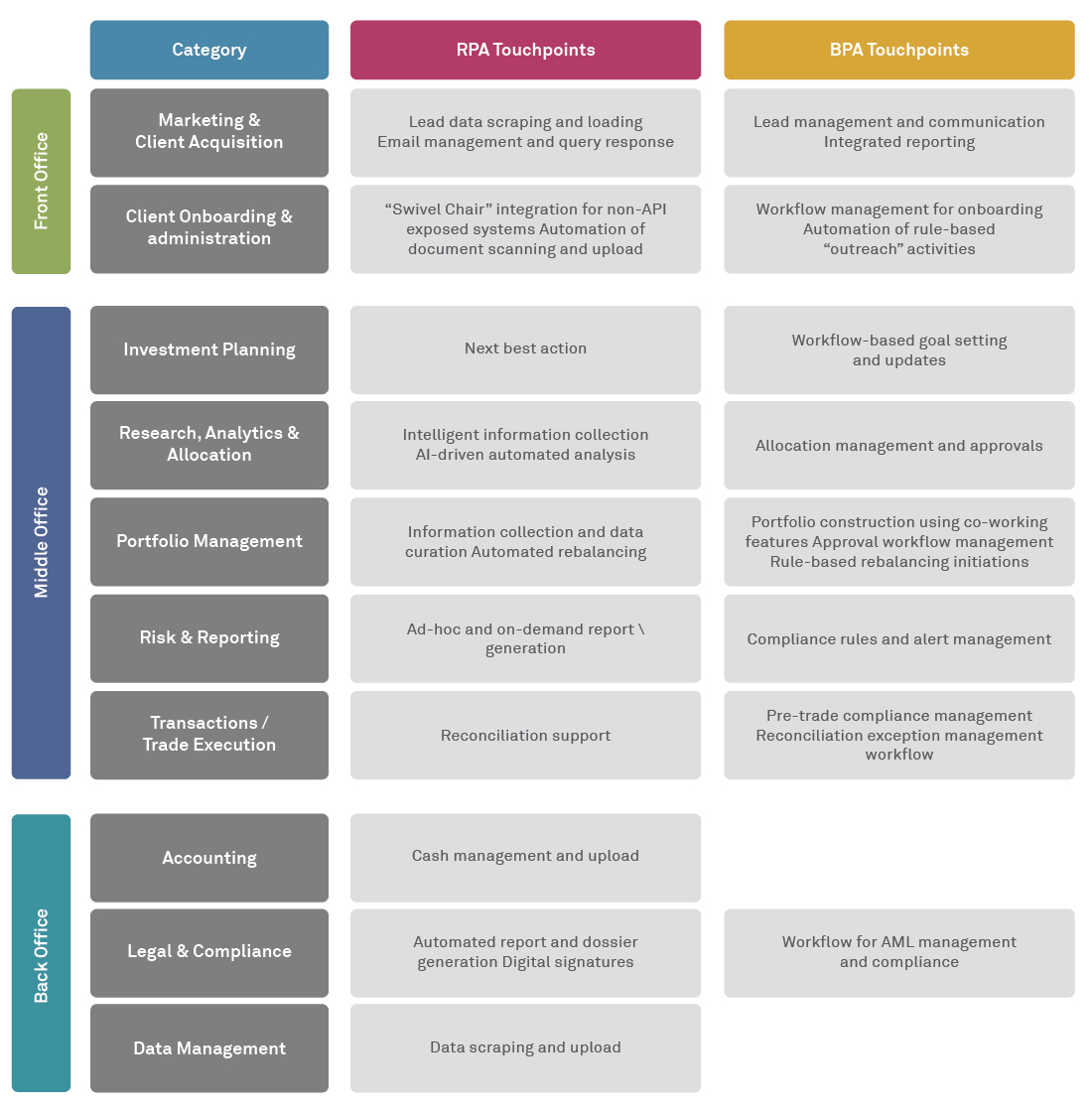
1.4. Enhancing scalability and operational proficiency by adopting cloud architecture
The Information Technology (IT) landscape within wealth management firms consists of legacy systems maintain a high volume of financial data, which requires increasing maintenance efforts and costs. As automation and AI/ML become more ingrained into wealth investment services, an explosion of financial data will drive automation processes and solutions. To handle the growing data influx at scale, cloud infrastructure can provide a more robust alternative to in-house legacy systems, while also delivering better operational efficiency and improved agility/time-to-market.
Wealth management firms can rationalize their existing application portfolio for cloud adoption by identifying the migration’s decision paths, which will drive the cloud migration strategy through the assessment, design, build, and migration stages.
1.5. Enhancing investor management and advisory services
Providing an enriched investor as well as advisory experience is pivotal to the wealth management industry. In addition to the human touch, digital personalization appeals very strongly to the new-age investors. AI and data-enabled marketing can create personalized content for prospective investors leading to improved client acquisition for wealth managers.
A transformed digital experience can drive customer engagement, thereby achieving a higher degree of customer retention and empowered advisors. A few touchpoints are detailed below:

2. Key Constraints Faced by Wealth Managers for Adopting Digital Strategies
The recent pandemic has forced wealth managers to be more convivial to digitalization. More than two-thirds of wealth managers3 feel that learning about and keeping up with new technology is their topmost challenge. Some of the most common challenges faced in the industry revolve around the following:
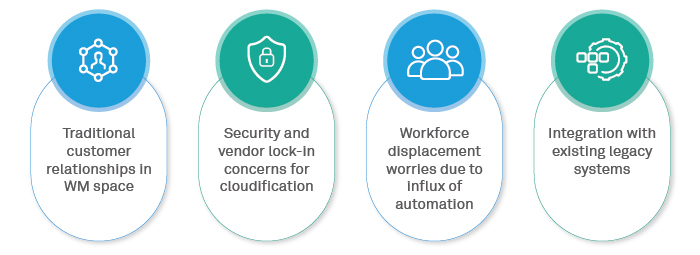
2.1. Traditional customer relationships in WM space
Because wealth management has been traditionally based on high-touch interactions and personal relationships, wealth managers are still struggling to find the right balance of digital and manual touchpoints. Most wealth managers today still see information technology as a support function rather than a core business strategy.
Low digital penetration levels across the industry are in stark contrast to the new-age clients’ digital preferences. The widening generational gap makes it harder for traditional wealth managers to understand and adjust to the younger, digital-centric clients’ needs and preferences, thereby weakening investor-advisor relationships. Traditional wealth managers have been slow in transitioning to enhanced digitalization. The pandemic and recent market disruptions have accelerated adoption, but this long-tailed gap will take longer to fill in.
The digital empowerment of wealth managers should be the top priority for leadership at WM firms. They can start by driving programs and training for enhancing tech and digital literacy. Building from these programs, wealth managers can adopt the hybrid approach with digital strategies to win over the new generation of investors.
2.2. Security and vendor lock-in concerns for cloudification
Although cloudification can lead to significant cost and effort savings, it is not without challenges or concerns. One major concern is the security of data residing with external cloud service providers. Firms are much more comfortable with in-house data systems than hosting sensitive data on a third-party cloud system. Also, financial firms are apprehensive about the risk of vendor lock-in, which would make it difficult to migrate cloud assets in the future.
Raising awareness on cloud technology and security features among senior decision-makers in wealth management firms will ease security concerns. This can be done through periodic demonstrations and presentations. Applying multi-cloud strategies (including orchestration and monitoring) can address the lock-in worries. Increased vulnerabilities of cybercrime and privacy issues can be answered with adaptive and impeccable security measures.
2.3. Workforce displacement worries due to the influx of automation
The existing workforce has always resisted automation, often based on misplaced concerns of displacement. The key to successful automation is change management, wherein wealth management advisors and middle/back office staff are educated on automation and its benefits to their work processes. Identifying champions within the employee fraternity, along with consistent and clear communication, can be critical to enabling a non-disruptive and effective transformation.
2.4. Integration with existing legacy systems
Most wealth managers are stuck with rigid legacy systems and disparate data sources implemented in silos to address a particular problem rather than a holistic transformation. As firms are gearing up for a full-blown digital transformation, they struggle to integrate/replace existing core systems with new digital experiences and mobile apps.
Firms can modernize the core systems (e.g., a multi-channel wealth management suite with front-to-back-office integration) to support compatibility with the latest technology and third-party systems with a focus on interoperability and cost-effectiveness. For example, a modern cloud-based and secure data management solution can easily and safely integrate with the latest front-end digital systems, compared to the legacy in-house data systems.
3. Opportunities for Digitalization across the Wealth Management Value Chain
Digitalization opportunities are evident across the wealth management value chain. An integrated digitalization transformation addressing all the relevant user touchpoints will enable an overall enhanced experience for investors and advisors. Digitalization levers can be mapped to each of the wealth management value chain’s constituents (Front office, Middle office and Back office).
Front office digitalization has a disproportionate impact on client experience. The focus is on frictionless interaction and enhanced digital UX to cut down on turnaround time, improve process efficacy, and ensure a smoother customer journey in line with Big Tech and Fintech experience.
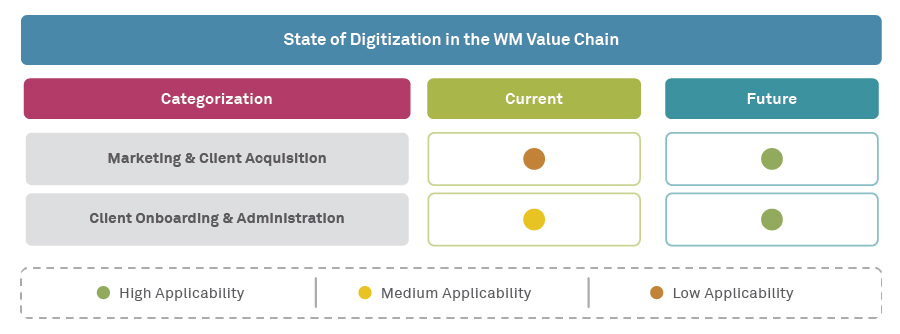
Front Office – Current and Future (Expected) Digitalization Maturity in WM value chain
In the middle office, which drives the core wealth management business, the focus clearly lies on data analytics. However, given the sensitivity of client data privacy concerns and regulations like GDPR and equivalent laws coming into force across the globe, a measured approach to data management and cloudification is the way forward.
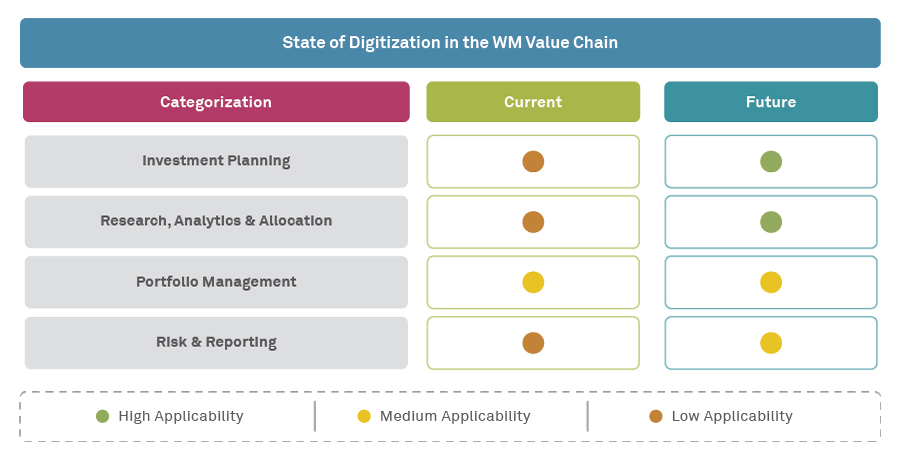
Middle Office – Current and Future (Expected) Digitalization Maturity in WM value chain
Digitalization opportunities in the back office space center on automation and cloudification. The user experience quotient is not very high primarily because the activities are more in-house driven rather than external stakeholder driven.
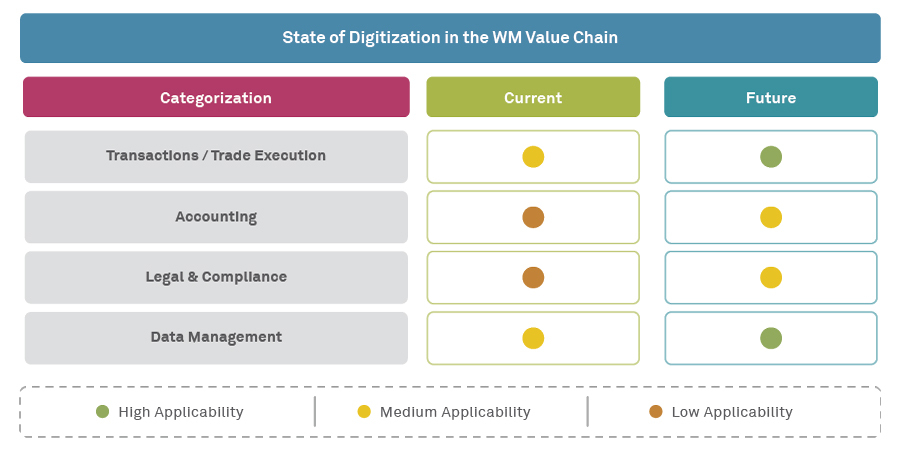
Back Office – Current and Future (Expected) Digitalization Maturity in WM value chain
In some of wealth management’s core activities, the impact of digitalization is already evident. The cases described below elucidate how the industry is unlocking value through enhanced digitalization.
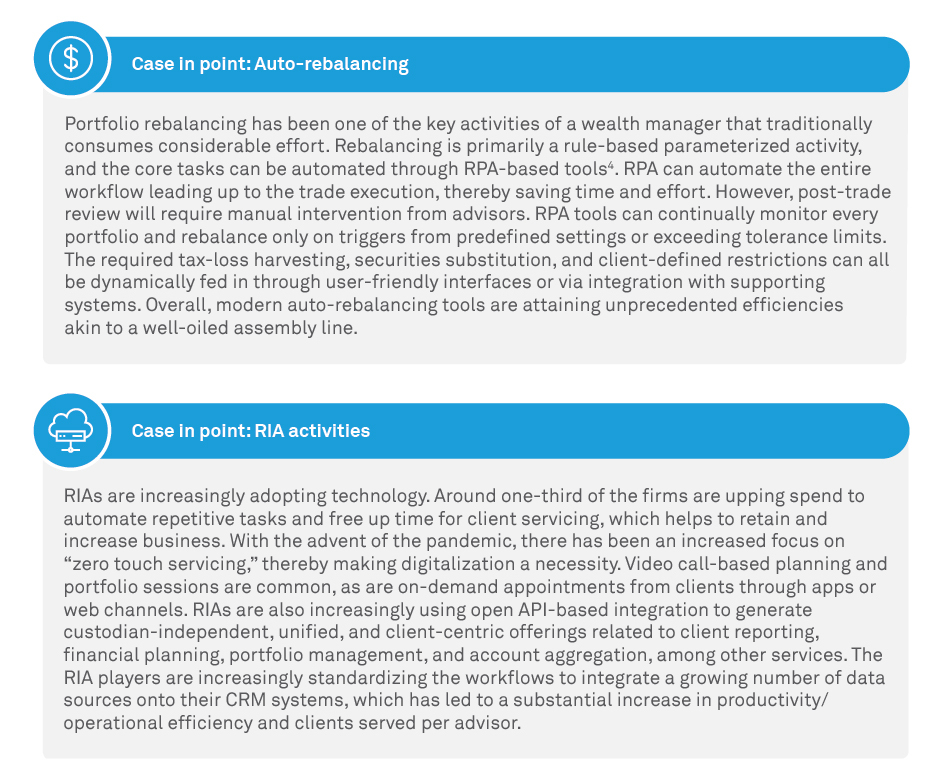
The Road Ahead
The global pandemic has accentuated the need to stay digitally connected and leaving a long-lasting impact on investors and wealth managers. The ways of working may have been modified forever, with the focus being on enabling a digital ecosystem built on tools and measures for a touchless remote experience without compromising on quality.
From a service and product perspective, the focus is steadily moving toward personalization, driven by effective data analysis. The spotlight is shifting toward tailored products, customized advisory services, and flexible pricing models for all investor classes. These changes have one strong enabler in common – the aggressive use of technology and accelerated digitalization either organically or inorganically. For people-centric and relationship-driven businesses like wealth management, effective use of technology through an omnichannel delivery model is essential to drive the right amount of customer collaboration. Firms can look forward to investing in in-house technology, aligning with tech vendor capabilities, and exploring strategic transactions with tech-enabled players (M&As, JVs, partnerships and R&D collaboration, etc.) for the timely enablement of modern investment solutions, staying relevant to diversified investor segments, and staying ahead of ever-increasing competition.
References
Pradeep Agarwal
Wipro Insights Lead - Capital Markets
Pradeep is the Wipro Insights lead in the Capital Markets vertical at Wipro. He has more than 12 years’ experience in the financial services sector, working with EY Transaction Advisory Services, HSBC Investment Banking, and Guggenheim Transparent Value. Pradeep is skilled at performing sector research, forming go-to-market strategies, consulting, capital advisory, M&A origination, and execution. You can reach him at pradeep.agarwal2@wipro.com.
Sharad Chandran R
Solution Design Consultant - Capital Markets
Sharad works as a consultant for developing IT solutions/response designs for customer proposals in the Capital Markets vertical at Wipro. He has around ten years’ experience across software development, IT strategy consulting, and sales strategy roles. He has proven acumen in architecting and designing digital solutions and implementing digital transformation for financial services clients. You can reach him at sharad.chandran@wipro.com.
Swarnabha Seth
Solution Design Lead - Capital Markets
Swarnabha is a solution design lead in the Capital Markets vertical at Wipro. He has more than 14 years’ experience across solution development, consulting, and sales strategy. He has a deep technical understanding of the digital space and has been instrumental in shaping large outcomes in the banking, insurance, and financial services domain. You can reach him at swarnabha.seth@wipro.com.